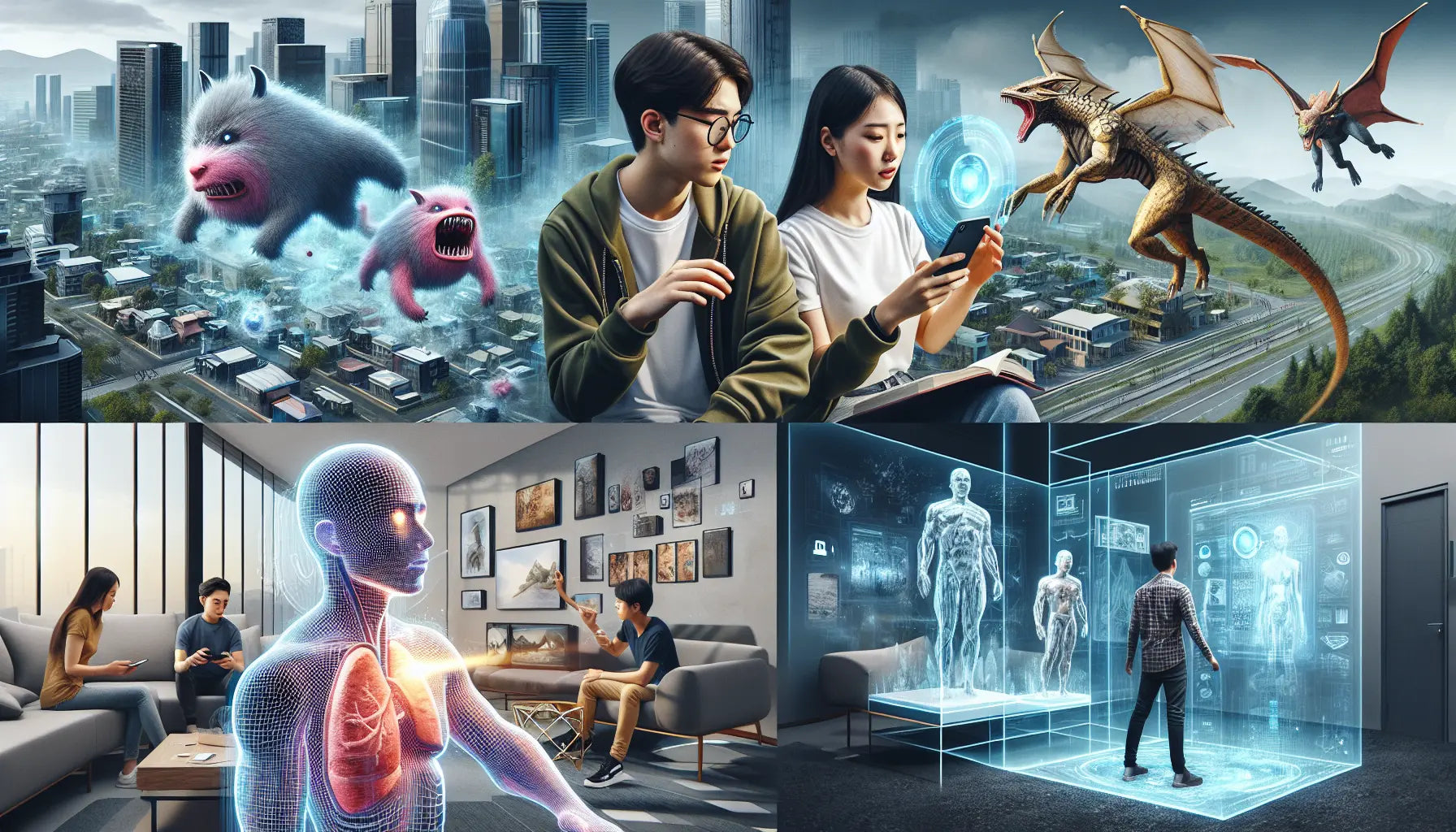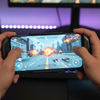The Transformative Power of Augmented Reality

Introduction
Augmented reality (AR) is a technology that overlays virtual information onto the real world, enhancing our perception and interaction with our surroundings. While the concept of AR has been around for some time, it wasn't until the release of Pokemon Go that it gained widespread attention and popularity. Pokemon Go demonstrated the transformative potential of AR, showing us how it could change the way we play games, learn, and even shop online.
AR has the power to revolutionize the gaming industry, allowing players to immerse themselves in virtual worlds and interact with virtual objects in their physical environment. With AR, gaming experiences become more realistic and engaging, blurring the lines between the real and virtual worlds. Furthermore, AR has the potential to revolutionize education by providing students with interactive and three-dimensional learning experiences. Apps like Anatomy X and Digg Space allow students to explore complex subjects like anatomy and space in a more intuitive and immersive way.
Additionally, AR has the ability to transform online shopping. With AR, shoppers can visualize how products will look in their own homes before making a purchase. Apps like magicplan and Amazon's AR feature make it easier to measure spaces and see how furniture and other items will fit in a room. This enhanced visualization makes the online shopping experience more convenient and personalized.
AR will change the world by enhancing our gaming experiences, revolutionizing education, and transforming the way we shop online. Its potential goes beyond these areas, and the possibilities are endless. As AR technology continues to advance, we can expect to see even more innovative applications that will reshape our daily lives.
AR in Gaming
One of the most exciting applications of augmented reality (AR) technology is in the world of gaming. Personal experience with AR games has shown the incredible potential of this technology to transform the gaming industry. With AR, players are able to change their viewing points and fully immerse themselves in the action, blurring the lines between the real and virtual worlds.
For example, games like Machines and Mammoth Mini Golf showcase the power of AR in gaming. In Machines, players can set up the playing field on a table and watch as virtual heroes battle it out in front of them. The ability to change viewing points and get up close with the action adds a new level of excitement and realism to the gaming experience.
Similarly, Mammoth Mini Golf allows players to play a round of mini golf with a virtual mammoth on the course. The game brings the virtual world into the real world, creating a fun and immersive experience. These examples demonstrate the potential of AR to enhance gaming experiences and provide players with a whole new level of excitement.
Looking ahead, there is even more excitement in store for AR gaming. The upcoming Harry Potter AR game, developed by Niantic, is highly anticipated by fans. This game will allow players to experience the magical world of Harry Potter in a whole new way, bringing their favorite characters and spells to life.
Overall, AR has the power to revolutionize the gaming industry by creating more immersive and realistic experiences. The ability to change viewing points and interact with virtual objects in the real world opens up a world of possibilities for game developers. With exciting games like Machines and Mammoth Mini Golf already available, and the promise of the upcoming Harry Potter AR game, it's clear that AR will continue to change the world of gaming.
AR in Education
Augmented reality (AR) has immense potential in the field of education, offering a new way for students to learn and engage with complex subjects. AR technology allows virtual information to be overlaid onto the real world, creating an enhanced learning experience that goes beyond traditional textbooks and lectures.
One example of AR's impact in education is through apps like Anatomy X and Digg Space. Anatomy X allows students to explore the human body in a three-dimensional and interactive way. Instead of simply looking at pictures in a textbook, students can use AR to view and dissect virtual models of the human body, making it easier to understand complex anatomical structures.
Digg Space, on the other hand, brings the wonders of space exploration into the classroom. Students can use AR to place and interact with 3D models of planets, moons, and spacecrafts right on their desks. This hands-on approach to learning about outer space fosters a deeper understanding and appreciation for the subject.
AR enhances the learning experience by providing students with an immersive and interactive environment. Instead of passively absorbing information, students can actively engage with the material through virtual simulations and manipulations. This not only makes learning more fun and engaging, but also helps students retain information more effectively.
One of the most exciting aspects of AR in education is the potential for future generations. As AR technology continues to advance, we can expect to see even more innovative applications that will revolutionize the way students learn. Imagine virtual field trips to historical landmarks, interactive language lessons that bring foreign cultures to life, and collaborative problem-solving exercises that bridge the gap between theory and practice.
With AR, the possibilities for education are endless. It has the power to transform traditional teaching methods and provide students with a more immersive and personalized learning experience. As we look to the future, we can be excited about the opportunities that AR will bring to education, empowering students and educators alike to explore and discover the world in new and exciting ways.
AR in Online Shopping and Home Improvement
Augmented reality (AR) is not only revolutionizing the gaming and education industries but also transforming the world of online shopping and home improvement. By incorporating AR technology, online shoppers and homeowners can now effortlessly measure and visualize products in real-world settings, enhancing their consumer experience and convenience.
Benefits of AR in Online Shopping and Home Improvement
AR brings several benefits to the world of online shopping and home improvement. Firstly, it allows shoppers to visualize how products will look in their own homes before making a purchase. This eliminates the uncertainty and guesswork of whether an item will fit or suit their space. Secondly, AR makes measuring spaces much easier. Apps like Magicplan enable users to measure walls, floors, and ceilings effortlessly, saving time and effort. Lastly, AR enhances the overall convenience by creating a personalized and tailored shopping experience.
App Examples: Magicplan and Amazon's AR Feature
Two popular examples of AR apps in the online shopping and home improvement space are Magicplan and Amazon's AR feature. Magicplan simplifies the measurement process by allowing users to measure spaces with just their smartphones, eliminating the need for manual measuring tools. On the other hand, Amazon's AR feature enables shoppers to visualize how furniture and other items will look in their homes before purchasing, providing a more immersive and realistic online shopping experience.
Effortless Measuring and Visualizing Products in Real-World Settings
With AR, measuring and visualizing products in real-world settings has never been easier. Users can simply point their devices and capture the dimensions of a room or space, eliminating the need for manual measurements. Additionally, AR overlays virtual furniture and decor onto the real-world environment, allowing users to see exactly how the items will look and fit in their homes. This seamless integration of virtual and physical spaces enhances the overall shopping and home improvement experience.
Impact on Consumer Experience and Convenience
AR technology has a significant impact on consumer experience and convenience. By providing a more immersive and realistic online shopping experience, AR enables consumers to make more informed decisions before purchasing. It eliminates the need for guesswork and returns, ultimately saving time and effort. Additionally, AR enhances convenience by bringing the shopping experience directly to the consumer's home, eliminating the need to visit physical stores.
In conclusion, AR technology is transforming various industries, including online shopping and home improvement. Its benefits, such as effortless measuring and visualization, app examples like Magicplan and Amazon's AR feature, and its impact on consumer experience and convenience, showcase the potential AR has to change the way we shop and improve our homes. As technology continues to advance, we can expect even more innovative applications of AR that will reshape our daily lives.
AR's Impact on Entertainment and Personalization
Augmented reality (AR) has expanded the possibilities for entertainment, bringing virtual experiences into the real world. With AR, users can immerse themselves in games and interact with virtual objects in their physical environment, blurring the lines between reality and fantasy. Games like Machines and Mammoth Mini Golf demonstrate the transformative power of AR in gaming, allowing players to change their viewing points and get up close with the action.
In addition to gaming, AR has also brought the world of GIFs and stickers into the real world. With AR, users can place and interact with their favorite GIFs and stickers in their physical surroundings, creating fun and personalized experiences. This technology allows users to capture and share these augmented experiences with others, adding a new level of entertainment to social media.
AR also offers unique apps such as World Brush, which turns the world into a canvas for virtual painting. Users can create artwork on any surface and explore their creations in an interactive and immersive way. Additionally, there are tattoo visualization apps that allow users to see what a tattoo would look like on their body before getting it done, providing a practical and personalized experience.
AR's impact extends beyond entertainment and into personalization. By overlaying virtual information onto the real world, AR enhances the way we shop online and improve our homes. Shoppers can use AR to visualize how products will look in their own homes before making a purchase, eliminating the uncertainty of whether an item will fit or suit their space. Apps like Magicplan make it easier to measure spaces and see how furniture and other items will fit, enhancing the convenience and personalization of the online shopping experience.
In conclusion, AR has revolutionized entertainment by expanding the possibilities for gaming, bringing GIFs and stickers into the real world, and offering unique apps like World Brush and tattoo visualization. It has also transformed the way we shop online and improve our homes, making the experience more personalized and convenient. As AR technology continues to advance, we can expect even more innovative applications that will reshape the entertainment industry and enhance personalization in various aspects of our lives.
Conclusion
AR has the potential to have a transformative impact on the world. Its ability to overlay virtual information onto the real world enhances our perception and interaction with our surroundings. From gaming to education to online shopping, AR is already revolutionizing various industries and reshaping our daily lives.
AR has revolutionized the gaming industry by creating more immersive and realistic experiences. Players can now fully immerse themselves in virtual worlds and interact with virtual objects in their physical environment, blurring the lines between reality and fantasy.
In the field of education, AR offers a new way for students to learn and engage with complex subjects. Apps like Anatomy X and Digg Space provide interactive and three-dimensional learning experiences, making it easier for students to understand and retain information.
AR is also transforming the world of online shopping and home improvement. Shoppers can now visualize how products will look in their own homes before making a purchase, eliminating the uncertainty and guesswork. Apps like Magicplan and Amazon's AR feature enhance convenience and personalization, making the online shopping experience more tailored to individual needs.
Overall, the potential of AR goes beyond these areas. As AR technology continues to advance, we can expect to see even more innovative applications that will reshape the way we experience and interact with the world.
What are your thoughts on AR and its potential impact? How do you think AR will change the world? Share your opinions in the comments below. And don't forget to like, subscribe, and comment for more exciting tech videos!
FAQ
What is augmented reality?
Augmented reality (AR) is a technology that overlays virtual information onto the real world, enhancing our perception and interaction with our surroundings. It combines elements of the physical and virtual worlds, allowing users to interact with virtual objects and environments in a real-world setting.
How did Pokemon Go contribute to the popularity of AR?
Pokemon Go, a popular mobile game released in 2016, played a significant role in popularizing augmented reality. The game allowed players to hunt for virtual Pokemon characters in the real world using their smartphones. It showcased the potential of AR technology and sparked widespread interest in its capabilities.
What are some examples of AR games?
Some examples of AR games include Machines, Mammoth Mini Golf, and the upcoming Harry Potter AR game. These games utilize AR technology to create immersive and interactive gaming experiences, allowing players to interact with virtual objects and environments in the real world.
How can AR enhance the learning experience?
AR has the potential to enhance the learning experience by providing students with interactive and three-dimensional learning experiences. Apps like Anatomy X and Digg Space allow students to explore complex subjects like anatomy and space in a more intuitive and immersive way. AR technology allows students to actively engage with the material and retain information more effectively.
Which apps utilize AR for online shopping?
Apps like Magicplan and Amazon's AR feature utilize AR technology to enhance the online shopping experience. These apps allow shoppers to visualize how products will look in their own homes before making a purchase. Magicplan simplifies the measuring process by allowing users to measure spaces with their smartphones, while Amazon's AR feature enables shoppers to see how furniture and other items will fit in their homes.
What are some creative uses of AR in entertainment?
AR has brought virtual experiences into the real world, creating exciting and immersive entertainment experiences. For example, users can place and interact with their favorite GIFs and stickers in their physical surroundings, adding a new level of fun and personalization to social media. Apps like World Brush turn the world into a canvas for virtual painting, allowing users to create artwork on any surface.
Can AR help with personalization and decision-making?
Yes, AR technology has the potential to enhance personalization and decision-making processes. In the world of online shopping, AR allows shoppers to visualize products in their own homes, helping them make more informed decisions before making a purchase. It eliminates the uncertainty of whether an item will fit or suit their space. Additionally, AR technology can be used for tattoo visualization, allowing users to see what a tattoo would look like on their body before getting it done.





